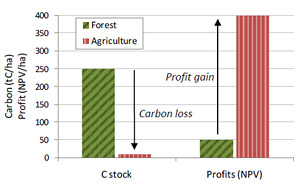Trade-offs and other REDD+ scenarios

The World Bank Institute which shares knowledge related to poverty reduction has recently published online a training manual for estimating REDD+ opportunity costs. The theory behind REDD+ and terms of art like “carbon dioxide equivalents” or “net present value” are demystified in accessible terms and helpful graphs. The guide is intended for “professionals within governments, universities, research institutions, international or non-governmental organizations and program developers who may use the presented methods and tools to estimate opportunity costs and incorporate these costs into recommendations for REDD+ policies and programs.” But it has elements for the layman as well.
Among the very didactic charts, two illustrate the fallacy of thinking of the trade-off between forests and agriculture as a lost cause for trees.
Carbon loss and profit gain from converting forests to agriculture (Figure 1.2 in Introduction chapter)

If alternative land uses such as pasture and agroforestry are brought into the picture, there are more reasons for optimism.
Carbon and profits of four land use categories (Figure 1.3 in same chapter)


By this account, pastures are less profitable than forests (and contain much less carbon), while agroforestry provides the highest profitability combined with very substantial carbon stocks. Investing in trees on farms could provide a win-win scenario, when farmers are trying to produce more food in a changing climate, while taking pressure off natural forests.








